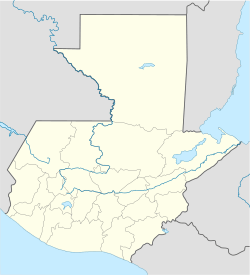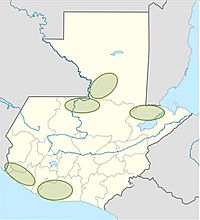Chisec facts for kids
Quick facts for kids
Chisec
|
|
|---|---|
|
Municipality
|
|
| Country | |
| Department | |
| Municipality | Chisec |
| Government | |
| • Type | Municipal |
| Area | |
| • Municipality | 1,244 km2 (480 sq mi) |
| Elevation | 230 m (750 ft) |
| Population
(Census 2018)
|
|
| • Municipality | 84,553 |
| • Density | 67.969/km2 (176.04/sq mi) |
| • Urban | 9,884 |
| • Ethnicities | Q'eqchi' Ladino |
| • Religions | Roman Catholicism Evangelicalism Maya |
| Climate | Af |
Chisec is a town and municipality in northern Guatemala. It is part of the Alta Verapaz region. The town was founded in 1813. It sits about 230 meters (755 feet) above sea level. The whole municipality covers an area of 1,244 square kilometers.
In 2018, the population of Chisec was 84,553 people. Most of the people, about 95%, are Mayan. They live in the main town of Chisec and in about 140 smaller communities. Some communities used to be part of Chisec but later joined the new municipality of Raxruha in 2008. In Chisec, people widely speak the Q'eqchi' language along with Spanish.
Contents
History of Chisec
The Northern Transversal Strip
Lua error in Module:Location_map at line 420: attempt to index field 'wikibase' (a nil value). The "Franja Transversal del Norte" (FTN) means "Northern Transversal Strip." This is a special area in Guatemala. The first big project to settle this area was in Sebol-Chinajá, which is in Alta Verapaz. Sebol was important because of the Cancuén River. This river connected to Petén through the Usumacinta River, near the border with Mexico. The only road there was a dirt road built in 1928.
In 1958, the Inter-American Development Bank (IDB) helped fund building projects in Sebol. Later, in 1960, a military captain named Fernando Romeo Lucas García owned farms in this area. He worked in the Guatemalan government to encourage more investment in this part of the country.
In 1962, a new law was made to help change how land was used. In 1964, the government defined the FTN. It included the northern parts of Huehuetenango, Quiché, Alta Verapaz, and Izabal. That same year, religious groups like the Maryknoll order helped people from Huehuetenango move to the Ixcán area in Quiché.
The Northern Transversal Strip was officially created in 1970. This was done by a special law to help with farming in the area.
Economy of Chisec
Oil Resources
In 1971, many Q'eqchi' people from 24 villages near Cancuén were asked to move by the Army. This was because the government believed the area had a lot of oil.
Since 1974, oil has been taken out of the ground in the FTN area. This happened after oil was found in the Rubelsanto oil field in Alta Verapaz. In 1976, the president of Guatemala visited an area called Mayalán. He said that Mayalán was "seated on top of the gold." This meant that the Northern Transversal Strip would be used for its natural resources, like oil, instead of just for farming.
After this visit, oil companies looked for oil near Mayalán. They drilled a well but did not find oil there. However, these early searches helped build the dirt road that runs through the Strip. This road was built between 1975 and 1979. It helped powerful business people and military leaders gain ownership of lands that had valuable timber and oil.
African Oil Palm
There is a big need for cooking oils and fats in Guatemala and nearby countries. This is why the African oil palm has become very common. New companies are investing a lot of money to grow this crop. They are especially active in parts of the Northern Transversal Strip. These companies want Guatemala to become a major exporter of palm oil, even if the price of palm oil goes down.
The main areas for growing oil palm are Chisec and Cobán in Alta Verapaz Department. Other active areas include Ixcán in Quiché Department and Sayaxché in Petén Department. Companies like Palmas del Ixcán, S.A. (PALIX) operate here. Another company, Naturaceites, works in Fray Bartolomé de las Casas and Chahal in Alta Verapaz. They also operate in El Estor and Livingston in Izabal Department, and San Luis in Petén.
Climate in Chisec
Chisec has a tropical climate. This means it is warm all year round and gets a lot of rain. It is classified as an Af climate according to the Köppen climate classification.
| Climate data for Chisec | |||||||||||||
|---|---|---|---|---|---|---|---|---|---|---|---|---|---|
| Month | Jan | Feb | Mar | Apr | May | Jun | Jul | Aug | Sep | Oct | Nov | Dec | Year |
| Mean daily maximum °C (°F) | 27.8 (82.0) |
29.6 (85.3) |
31.0 (87.8) |
32.4 (90.3) |
32.4 (90.3) |
32.1 (89.8) |
30.8 (87.4) |
31.1 (88.0) |
30.8 (87.4) |
30.1 (86.2) |
29.1 (84.4) |
27.9 (82.2) |
30.4 (86.8) |
| Daily mean °C (°F) | 23.1 (73.6) |
24.0 (75.2) |
25.6 (78.1) |
26.8 (80.2) |
27.2 (81.0) |
27.3 (81.1) |
26.5 (79.7) |
26.5 (79.7) |
26.3 (79.3) |
25.8 (78.4) |
24.7 (76.5) |
23.1 (73.6) |
25.6 (78.0) |
| Mean daily minimum °C (°F) | 18.4 (65.1) |
18.4 (65.1) |
20.2 (68.4) |
21.2 (70.2) |
22.1 (71.8) |
22.5 (72.5) |
22.2 (72.0) |
22.0 (71.6) |
21.9 (71.4) |
21.5 (70.7) |
20.3 (68.5) |
18.3 (64.9) |
20.8 (69.4) |
| Average precipitation mm (inches) | 152 (6.0) |
96 (3.8) |
98 (3.9) |
99 (3.9) |
214 (8.4) |
385 (15.2) |
387 (15.2) |
343 (13.5) |
427 (16.8) |
386 (15.2) |
252 (9.9) |
184 (7.2) |
3,023 (119) |
| Source: Climate-Data.org | |||||||||||||
Where is Chisec Located?
Chisec is surrounded by other municipalities and departments.
 |
Sayaxché, El Petén municipality |  |
||
| Cobán, Alta Verapaz municipality and Ixcán, El Quiché municipality | Raxruha, Alta Verapaz municipality | |||
| Cobán and San Pedro Carchá, Alta Verapaz municipalities. |
See also
 In Spanish: Chisec para niños
In Spanish: Chisec para niños



